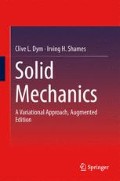Abstract
This chapter will be devoted to considerations of certain of the foundations underlying the theory of elastic stability. We will examine the meaning of stability especially within the context of variational methods and discuss various methods of obtaining stability bounds for various problems. As a recurring example problem we shall make use of the simple Euler column problem to indicate a variety of approaches. Using variational techniques we shall set forth approximate techniques for solving stability problems involving columns and plates.
Access this chapter
Tax calculation will be finalised at checkout
Purchases are for personal use only
Notes
- 1.
Recall from Sec. 2.4 that:
$$F(\theta + \delta \theta ) - F(\theta ) = {\delta ^{(T)}}F$$ - 2.
In this discussion a function F(x i ) is said to be positive definite if the function is greater than zero in a neighborhood about x i = 0 and can equal zero only at the position x i = 0.
- 3.
The first term represents the bending strain energy while the expression \({\textstyle{1 \over 2}}\int_0^L {{{(dx{\rm{/}}dx)}^2}\,dx}\) represents an approximation of the contraction of the column along the x axis.
- 4.
Consult any standard advanced calculus book for Taylor series expansions in n variables.
- 5.
See J. LaSalle and S. Lefschetz: “Stability by Liapounov’s Direct Method,” Academic Press, New York, 1961, p. 36.
- 6.
E. Trefftz: “Zur Theorie der Stabilität des Elastischen Gleichgewichts,” Zeitschrift für Angewandte Mathematik und Mechanik, Vol. 13, 1933, pp. 160–165.
- 7.
Remember that π is a function of the b’s and is not a functional here.
- 8.
Note that if a 1 is large, the assumptions regarding linear elasticity with small rotations may be violated long before P reaches the buckling load P E .
- 9.
It is actually the same form as the exact equation for the simple pendulum.
- 10.
M. Abramowitz and I. A. Stegun, (eds.): “Handbook of Mathematical Functions,” U.S. Department of Commerce, National Bureau of Standards, Vol. 55, Applied Mathematics Series, 1965.
- 11.
It is important to remember that the Koiter theory (as will be developed) is applicable only to bifurcation point buckling and not to limit point buckling.
- 12.
A translation of the “Stability of Elastic Equilibrium,” W. T. Koiter: AFFDL-TR-70-25. Air Force Flight Dynamics Laboratory, Wright-Patterson Air Force Base, Ohio, February, 1970; or NASA Report TTF-10, 833, 1967.
- 13.
A very important assumption is involved here, i.e., that a unique mode shape corresponds to the (unique) buckling load.
- 14.
For a recent survey of the field see Hutchinson, J. W. and Koiter, W. T.: “Postbuckling Theory,” Applied Mechanics Reviews, 1970, p. 1353.
- 15.
Note we have taken compression as positive for the applied loads and have reversed the direction of \(\bar N\) xy as positive.
- 16.
Note that for x = a, and x = 0, M v becomes M x and from Eq. (6.12(a)) we see that for a simply-supported straight edge the requirement for M x = 0 leads to the requirement that ∂2 w/∂x 2 = 0.
- 17.
We can reach the same conclusion by treating m as a continuous variable and we then minimize k cr with respect to m. Thus:
$${{\partial {k_{{\rm{cr}}}}} \over {\partial m}} = 0$$This gives us m = a/b.
- 18.
This results from axial symmetry and the exclusion of discontinuities of slope.
- 19.
See any standard advanced mathematics text such as “Advanced Engineering Mathematics,” C. R. Wylie, McGraw-Hill Book Co., Chap. 8 for a discussion of Bessel functions including differentiation properties.
- 20.
For a thorough discussion of the Kantorovich method and its extension for this problem see “An Extended Kantorovich Method for the Solution of Eigenvalue Problems,” by Arnold D. Kerr, International Journal of Solids and Structures, 5, 559–572 (1969).
Author information
Authors and Affiliations
Rights and permissions
Copyright information
© 2013 Springer Science+Business Media New York
About this chapter
Cite this chapter
Dym, C.L., Shames, I.H. (2013). Elastic Stability. In: Solid Mechanics. Springer, New York, NY. https://doi.org/10.1007/978-1-4614-6034-3_9
Download citation
DOI: https://doi.org/10.1007/978-1-4614-6034-3_9
Published:
Publisher Name: Springer, New York, NY
Print ISBN: 978-1-4614-6033-6
Online ISBN: 978-1-4614-6034-3
eBook Packages: EngineeringEngineering (R0)

